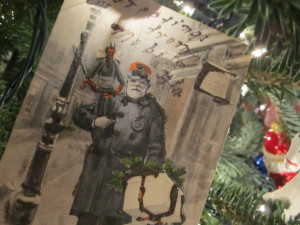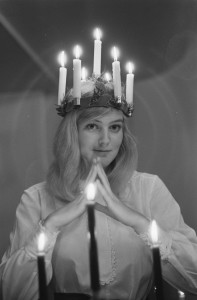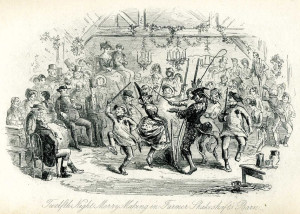
The first of the midwinter Gift Bearers arrives on the 5th of December: St. Nicholas. He is a much older cousin of the American Santa Claus, but there are striking similarities. On the Eve of St. Nicholas, which is tonight, children throughout Europe place their shoes by the chimney before going to bed for St. Nicholas to fill with gifts, as well as set out carrots and hay for his donkey. Good children might wake up the next morning on St. Nicholas’ Day to find their shoes filled with fruits and nuts and sweets. He is the first of many gift bearers across cultures that wend their way through the midwinter darkness. He’ll be followed over the next few weeks by the Christkindl, by Father Christmas and Santa Claus, by los Tres Reyes (the Three Kings) and a kind old witch named Befana.
The Feast of St. Nicholas is celebrated on the 6th of December. He is sacred to countries throughout Europe, but especially to Russia, Greece, the Netherlands, Germany, and Italy (Bari, in particular, where his relics are kept at the Basilica di San Nicola). Nicholas was a bishop of Myra, in southern Turkey, in the fourth century. He is most famous for his generosity, and this, perhaps, is the reason he is connected with the bestowing of presents. One story that has come down through the ages tells of three sisters who were without dowries, for their father was very poor. The situation became so desperate that the father decided his only option was to sell his daughters into prostitution. Nicholas heard of the problem and took action: one night as the household lay sleeping, he tossed a bag of gold through the open window, and suddenly the eldest daughter had a dowry. In time, he did the same for each of her sisters, too. He bestowed these gifts in secret, until the third time, when the father of the girls caught him in the act. He was forever grateful to the good bishop, and thus the legend of St. Nicholas as a gift bearer began.
The Eve of St. Nicholas and its related traditions are, in some places, of greater importance than the arrival of Santa Claus on Christmas Eve. Santa is a relative newcomer compared to St. Nicholas. And one thing St. Nicholas has that Santa doesn’t is a dark companion. He goes by many names throughout Europe: Knecht Ruprecht, Black Peter, Pelznickel… but this dark companion is best known as Krampus. In fact, the 5th of December is known in some parts as Krampusnacht. Krampus is most often depicted with horns on his head, a very long tongue, and cloven hooves or sometimes one human foot and one goat foot. The punishment by Krampus is pretty harsh: he carries switches and rusty chains for the express purpose of swatting naughty children, and then he’ll stuff them in a sack or a basket and carry them off to hell. Serious stuff. And while the American Santa Claus has to do it all––reward good children with gifts and punish naughty ones with coal––you might think of St. Nicholas as a wiser man, a delegator: he gets to take care of the good kids, but he gives the task of punishing the bad ones to Krampus.
So do be good. St. Nicholas would love to fill your shoes with fruits and nuts and sweets tonight. And if you’ve been bad…. Beware the Krampus!
*
This is a slightly edited version of a Convivio Book of Days chapter that was first published on Krampusnacht, 2013. We learn so much from reader comments and here are two that were posted after the original publication of this chapter: Kelly O’Brien wrote, “I live in Germany & just experienced my first Krampus fest in the Austrian Tyrol region over Thanksgiving. It was terrifying! Not only do modern-day Krampus tout chains and whips, but parade through the village with torches and lots of other fiery devices. The costumes & masks were creepy beautiful, apparently a source of local craftsmanship pride. Do you think this is where ‘going to hell in a hand basket’ comes from?”
And Tad DuBois wrote, “I live and work in Germany and we went to sleep to howling winds last night and awoke to snow and ice. The neighbor’s kinder were all standing in front of their windows watching the snow fly (and no doubt hoping for school cancellations). At my office this morning St. Nicholas and Krampus have just visited. St Nicholas dispensed candy canes and Krampus had little bags of something dark, coal or reindeer turds perhaps (actually was dark chocolate molded to resemble bits of coal). To be truthful, the Krampus who visited seemed to be a mash-up of Eye-gore from ‘Young Frankenstein’ and Riff-Raff from ‘Rocky Horror.’ Still a wonderful tradition.”
The image above is from an old penny postcard sent to us by our good friend Linda Dailey in Maine. Is it St. Nicholas garbed in modern day clothing rather than his traditional bishop’s robes? Perhaps. And that, for sure, is a Krampus doll in his hands, just to remind us all to be as good as we can. Sweet dreams.


